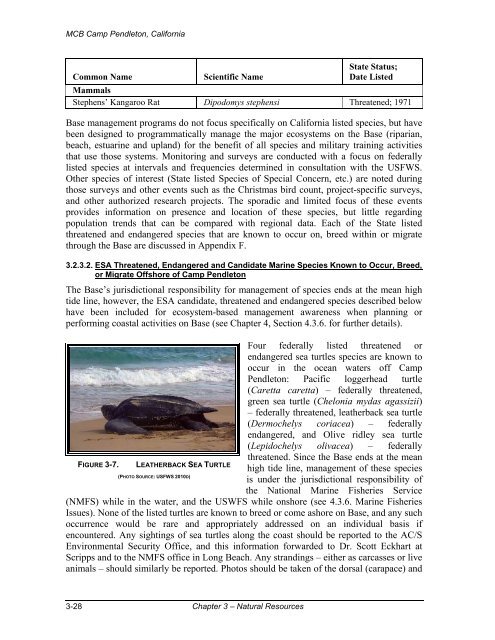Chapter 3 - Natural Resources - Marine Corps Base Camp Pendleton
Chapter 3 - Natural Resources - Marine Corps Base Camp Pendleton
Chapter 3 - Natural Resources - Marine Corps Base Camp Pendleton
You also want an ePaper? Increase the reach of your titles
YUMPU automatically turns print PDFs into web optimized ePapers that Google loves.
MCB <strong>Camp</strong> <strong>Pendleton</strong>, California<br />
Common Name<br />
Scientific Name<br />
State Status;<br />
Date Listed<br />
Mammals<br />
Stephens’ Kangaroo Rat Dipodomys stephensi Threatened; 1971<br />
<strong>Base</strong> management programs do not focus specifically on California listed species, but have<br />
been designed to programmatically manage the major ecosystems on the <strong>Base</strong> (riparian,<br />
beach, estuarine and upland) for the benefit of all species and military training activities<br />
that use those systems. Monitoring and surveys are conducted with a focus on federally<br />
listed species at intervals and frequencies determined in consultation with the USFWS.<br />
Other species of interest (State listed Species of Special Concern, etc.) are noted during<br />
those surveys and other events such as the Christmas bird count, project-specific surveys,<br />
and other authorized research projects. The sporadic and limited focus of these events<br />
provides information on presence and location of these species, but little regarding<br />
population trends that can be compared with regional data. Each of the State listed<br />
threatened and endangered species that are known to occur on, breed within or migrate<br />
through the <strong>Base</strong> are discussed in Appendix F.<br />
3.2.3.2. ESA Threatened, Endangered and Candidate <strong>Marine</strong> Species Known to Occur, Breed,<br />
or Migrate Offshore of <strong>Camp</strong> <strong>Pendleton</strong><br />
The <strong>Base</strong>’s jurisdictional responsibility for management of species ends at the mean high<br />
tide line, however, the ESA candidate, threatened and endangered species described below<br />
have been included for ecosystem-based management awareness when planning or<br />
performing coastal activities on <strong>Base</strong> (see <strong>Chapter</strong> 4, Section 4.3.6. for further details).<br />
Four federally listed threatened or<br />
endangered sea turtles species are known to<br />
occur in the ocean waters off <strong>Camp</strong><br />
<strong>Pendleton</strong>: Pacific loggerhead turtle<br />
(Caretta caretta) – federally threatened,<br />
green sea turtle (Chelonia mydas agassizii)<br />
– federally threatened, leatherback sea turtle<br />
(Dermochelys coriacea) – federally<br />
endangered, and Olive ridley sea turtle<br />
(Lepidochelys olivacea) – federally<br />
threatened. Since the <strong>Base</strong> ends at the mean<br />
FIGURE 3-7. LEATHERBACK SEA TURTLE<br />
high tide line, management of these species<br />
(PHOTO SOURCE: USFWS 2010D)<br />
is under the jurisdictional responsibility of<br />
the National <strong>Marine</strong> Fisheries Service<br />
(NMFS) while in the water, and the USWFS while onshore (see 4.3.6. <strong>Marine</strong> Fisheries<br />
Issues). None of the listed turtles are known to breed or come ashore on <strong>Base</strong>, and any such<br />
occurrence would be rare and appropriately addressed on an individual basis if<br />
encountered. Any sightings of sea turtles along the coast should be reported to the AC/S<br />
Environmental Security Office, and this information forwarded to Dr. Scott Eckhart at<br />
Scripps and to the NMFS office in Long Beach. Any strandings – either as carcasses or live<br />
animals – should similarly be reported. Photos should be taken of the dorsal (carapace) and<br />
3-28 <strong>Chapter</strong> 3 – <strong>Natural</strong> <strong>Resources</strong>

















